Big brands make sustainable strides
January 30, 2014
Several firsts marked the announcement of the winners of the DuPont Awards for Packaging Innovation from DuPont Packaging & Industrial Polymers' (www.dupont.com). For one, DuPont announced the international awards online this year as part of its first virtual webcast event. Another new element to the competition is the basis for which the winners were judged: Efforts to enhance sustainability and performance. Key innovations include a generous use of post-consumer-recycled (PCR) materials and shelf-stabilization/transportation efficiencies, source reduction, energy efficiencies, responsible resourcing and solutions for end of life.
An independent, international judging panel facilitated by Anne Johnson, director of the Sustainable Packaging Coalition, evaluated more than 120 entries in this year's competition on seven innovation factors—also new to this year's competition—such as resource and energy optimization and enhanced performance—selecting 10 winners and eight notable accomplishments. Here are the top 10 winners:
Shampoo bottle, cap promote PCR
Rethinking waste, Aveda Corp., Blaine, MN, part of the Estee Lauder Cos., celebrated its 30th anniversary by relaunching one of its original shampoos in what it calls a breakthrough sustainable package. Aveda's Vintage Clove shampoo (1) was part of a proactive, company-funded bottle-collection program and outreach at retail stores and schools internationally. The majority of Aveda's shampoo bottles contain 80 percent PCR, which totals more than 300,000 lb of recycled plastics used annually in the company's HDPE bottles. For outstanding producer involvement and commitment to a takeback program and innovative use of post-consumer-recycled 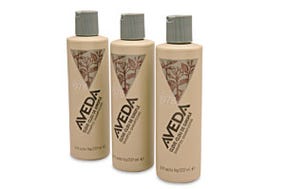 material, Aveda converted to a bottle made with 96-percent PCRHDPE content and caps made with 100-percent PCRPP and 4-percent colorant carrier virgin resin. The amount is the highest level of PCRHDPE for an Aveda shampoo bottle molded by Matrix Packaging (www.matrixpackaging.com), reports Karen Copp, corporate packaging innovations specialist at The Estee Lauder Cos. Inc., New York City.
material, Aveda converted to a bottle made with 96-percent PCRHDPE content and caps made with 100-percent PCRPP and 4-percent colorant carrier virgin resin. The amount is the highest level of PCRHDPE for an Aveda shampoo bottle molded by Matrix Packaging (www.matrixpackaging.com), reports Karen Copp, corporate packaging innovations specialist at The Estee Lauder Cos. Inc., New York City.
The PCRHDPE source is recycled milk jugs. TricorBraun (www.tricorbraun.com) supplies the bottle to Aveda, which has the bottle decorated by Technigraph (www.technigraph.net). “The graphic design drew inspiration from those used on the original Clove Pure Plant package so that regular customers would recognize it,” notes Dean Maune, executive director of Aveda package development. To top if off, the 100-percent PCR dispensing cap is the result of Aveda's new cap-collection/recycling program. “The cap project began as a way of reusing plastics polluting the oceans,” explains Estee Lauder vp John Delfausse. “We thought, better than taking them out, let's keep them from getting in the water at all (and wreaking havoc with birds and sea life),” Delfausse says.
Loose bottle caps aren't easily recovered, reprocessed and/or recycled by U.S. recycling centers, so the company built its own infrastructure to manage the recycling, he says. “We have been working with more than 60 schools to collect, sort and reprocess caps.” The caps are sent to KW Plastics (www.kwplastics.com) in Alabama, where they are washed, ground up and formed into pellets. The pellets are sent to Seaquist Closures (www.seaquistclosures.com), which uses them to mold new caps, which end up gray in color as a result of the rainbow of recycled, colored caps obtained.
“The color was worked into the new bottle graphics to give the design a pop,” Delfausse says. Label copy on the bottle promotes recycling and the judges recognized the package for achievements in community education and responsible sourcing. Aveda produces the shampoo at a facility in Blaine, which uses 100-percent wind power in its production operation. A pioneer in environmental practices, Aveda funds new wind energy sources that generate enough wind energy to offset 100-percent of the electricity used by its manufacturing facility, distribution facility and corporate headquarters in Blaine, according to Bopp.
“Our mission is to care for the world we live in, from the products we make to the ways in which we give back to society,” notes Delfausse. “We strive to set an example for environmental leadership and responsibility—not just in the world of beauty, but around the world. This packaging system supports our principal goal at Aveda, minimizing our ecological footprint. A major part of accomplishing this goal is achieved by using the highest level of post consumer content.”
Compostable bakeware
A renewable, compostable rigid tray (2) makes it possible for Whole Foods to reinvent its retail baking practices and simplify supply-chain operations with substantial waste reduction.
Recognized for enhanced performance, resource and energy optimization and effective recovery, Whole Foods' new compostable bakeware from Sealed Air Corp. (www.sealedair.com) together with Biosphere Industries, LLC (www.biosphereindustries.com), launched the Renew-A-Pak™ baking trays. Designed for dual-ovenability, microwavability and maintaining structural rigidity in freezing temperatures and extreme heat up to 420 deg F, the trays are made of a renewable starch-based composition and withstand the same kind of 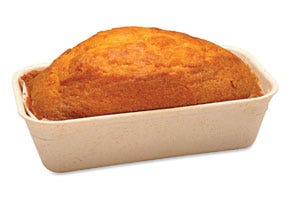 punishment as conventional metal bakeware, and pans. But they begin to biodegrade outdoors in 40 days or less (depending on precipitation conditions), or 10 days in a commercial compost environment. The trays can also be disposed of in the paper-recycling stream. Yet they can enjoy an indoor shelf life of many years, Sealed Air says. Moisture is a factor in the degradation of the product, points out Charles Dunlap, Sealed Air's director of sales and marketing.
punishment as conventional metal bakeware, and pans. But they begin to biodegrade outdoors in 40 days or less (depending on precipitation conditions), or 10 days in a commercial compost environment. The trays can also be disposed of in the paper-recycling stream. Yet they can enjoy an indoor shelf life of many years, Sealed Air says. Moisture is a factor in the degradation of the product, points out Charles Dunlap, Sealed Air's director of sales and marketing.
Part of a growing family of earth-friendly, high-performance packaging, Renew-a-Pak bakeware stays cool to the touch, reducing the threat of burnt hands. It doesn't need to be washed, which conserves water and energy used to wash baking dishes, and reduces the amount of dishwashing detergent discharged in waterways, Sealed Air says.
Most importantly, the bakeware incorporates 100-percent-renewable content. Whole Food Markets uses them for in-store-baked banana nut bread. “Biosphere Industries has been developing technology for starch-based packaging systems for more than seven years,” explains Dunlap. “We have partnered with them to offer a package that is environmentally friendly and also provides a cost savings in the process.” Along with bread loaf pans, Whole Foods is evaluating other Renew-a-Pak bakery containers, including muffin trays and pie pans. Whole Foods' previous bakery practices were to bake items in disposable metal trays and transfer the baked goods to a second package for in-store sales. The secondary packaging would be disposed of by consumers as waste.
Now, the products remain the dual-ovenable, microwavable tray from point of production to the consumer level and may be used from freezer to oven to table.
In the partnership with Sealed Air, Biosphere Industries offers the equipment, tooling and mold development services to produce the container, while Sealed Air provides its research center and customer-application testing facility as well as turnkey solutions from packaging materials to equipment and market know-how, marketing and customer service. Biosphere joined forces with Sealed Air in 2006 as a joint venture partner to bring sustainable, biodegradable packaging to market.
The container material isn't converted from starch into plastic; instead it's baked, similarly to the process of making bread, waffles or ice cream cones. This clean, advanced, two-step “'ice cream cone-baking” technology involves no harsh chemicals or plastics, PD is told. Steam is the only by-product of the minimal-waste manufacturing process. The base material is engineered to be made primarily of starches such as tapioca, potatoes and a smaller percentage of grass fiber and other raw materials harvested yearly, Biosphere Industries says. “We have a number of customers using the containers in varying applications,” adds Dunlap.
Pitcher-shaped pouch cuts material use
Direct from Helsingborg, Sweden, comes a lightweight approach to aseptic packaging of dairy products that cuts package weight in half. Using a material structure that significantly reduces raw materials, Ecolean Group's (www.ecolean.com) standup pouches (3) have a cleve, “pitcher-like” design noted by judges for enhanced performance and cleaner production.
An international company with headquarters, manufacturing and development in Sweden and manufacturing in China (for Asia and Pacific markets), Ecolean has commercial activities in 30 countries, the largest markets being China and Russia. The company develops and manufactures packaging systems for liquid foods as well as the packaging materials and filling machines associated with them.
Typically weighing 40 to 50 percent less than most conventional liquid food cartons and bottles, the Air Aseptic pouches are aseptically filled on Ecolean's compact EL3 machine designed for low-acid food products. All process connections are isolated with steam barriers to ensure the full aseptic integrity of the product supply, as well as that of the filling machine. The low-acid food product, the filling equipment and the package form a contamination-free chain where risks are controlled or avoided, says Ecolean. The pouch uses little raw material and saves energy during production, transport and waste handling, the company notes. Film structures are used to make the pouch instead of carton board. This helps save resources and energy, the company says. Interestingly, calcium carbonate (chalk) is in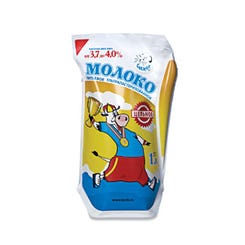 corporated in the structure to reduce the amount of polymer needed.
corporated in the structure to reduce the amount of polymer needed.
The lower weight and volume mean that more packages can be shipped per truck. Once empty, the pouch is as flat as an envelope, saving space in the trash bag, and has a positive effect on the waste-handling process.
“We want to offer a modern, aseptic packaging system that is easy to operate and a package that satisfies the demands of the consumers,” says Peter L. Nilsson, managing director. “We have chosen a completely new approach.” An empty pouch comprises a multilayer polymer film that's 140 microns (5.5+ mils) thick, and weighs 14 g—about half of most paperboard cartons, Nilsson reports. Nilsson also says the package saves resources as it's being made instead of saving them when it's thrown away. The pouch also has a sturdy, air-filled handle that enhances the pitcher design and gives the pouch a stiff back that makes it easy to grasp. Produced by Ecolean, the five-layer Calymer™ pouch structure, from the outside, is a durable PP printing layer, a mineral-filled PP layer that adds stiffness, an ethylene vinyl alcohol (EVOH) oxygen barrier layer, a carbon black layer to protect against light and and a PE sealing/food-contact layer. The packaging material is folded, shaped and sealed in proprietary Ecolean machines to produce rollstock of individual, ready-to-fill pouches.
Ecolean offers the equipment and packaging together, but the Calymer material itself isn't sold separately. The filled pouch is then hermetically sealed and sterilized, and the process is monitored and traceable down to individual packages. Sterilized using what Ecolean calls a dry, nonchemical process, the pouch ensures that the food contained inside is never exposed to chemicals during manufacturing or filling. Ecolean's marketing manager Louis Hobroh tells PD that the sterile filling process takes only about 2 sec. “The system isn't yet offered in the U.S.,” she points out.
The electron-beam (EB) sterilization process is separate from filling and is performed in-house by Ecolean. The sterilization has no effect on material properties like strength, color or odor, PD learns. The premade pouches come in sizes from 0.05 to 1 L, Hobroh says, adding that the company is developing an aseptic pouch to be compatible with high-acid products. Ultra-high-temperature (UHT) milk is the current application, but soon, the pouch could be used to pack fruit juices and other liquid food products.
New/old RPET food trays
ConAgra's new PCR PET-containing trays for frozen foods (4) include 40 percent post-consumer-recycled PET, which reduces the need for virgin PET and supports the frozen food tray market for post-consumer-recycled material. In development a bit more than one year, the trays are so far being used for about 100 SKUs across ConAgra's frozen-meal brands, including Healthy Choice Select Entrées, Complete Meals and All Natural Entrées as well as dinners in the Marie Callender's brand, Kid Cuisine and select Banquet entrées.
The trays were developed and thermoformed in various thicknesses (depending on the specific tray-pack) by Associated Packaging Technologies (APT [www.aptechnologies.com]). Exhibiting advancements in materials technology, they optimize resources and energy, offer clean production and responsible sourcing, say 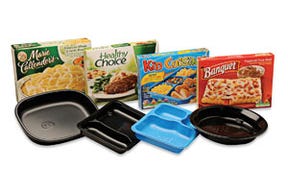 judges. The PCR content is obtained from recycled PET beverage bottles. The trays are a first in dual-ovenable food packaging, says ConAgra. Typically, this kind of tray is made using virgin CPET because of cleanliness requirements, points out Gail Tavill, vp of sustainable development research, quality and innovation. ConAgra met requirements set by the U.S. Food and Drug Administration for the use of PCR content in this particular application. Through ConAgra Foods' partnership with APT, a proprietary, ultra-clean RPET resin was qualified for commercial use in the Healthy Choice frozen meal trays and meets FDA regulations for direct food contact. APT calls the material RePET.
judges. The PCR content is obtained from recycled PET beverage bottles. The trays are a first in dual-ovenable food packaging, says ConAgra. Typically, this kind of tray is made using virgin CPET because of cleanliness requirements, points out Gail Tavill, vp of sustainable development research, quality and innovation. ConAgra met requirements set by the U.S. Food and Drug Administration for the use of PCR content in this particular application. Through ConAgra Foods' partnership with APT, a proprietary, ultra-clean RPET resin was qualified for commercial use in the Healthy Choice frozen meal trays and meets FDA regulations for direct food contact. APT calls the material RePET.
Says Tavill, “The RPET in the tray reduces the amount of virgin PET required to support our business by 8 million pounds per year—the equivalent of removing 145,000,000 frozen food trays from the wastestream. Because of that, 236 million BTUs of energy can be saved per year.” Adds George Frederick, APT's vp of sales and marketing, “The proprietary formula used for the tray material provides superior frozen impact-performance for CPET dual-ovenable trays.'
APT produces more than a dozen different tray configurations. It thermoforms those for ConAgra on Davis Standard (www.davis-standard.com) extruders and Lyle Industries (www.lyleindustries.com) systems, which utilize conventional and in-line thermoforming as well as proprietary rotary thermoforming technology, Frederick tells PD.
The draw depth of each tray is 1 to 2 in., on average, Frederick adds, and the thickness is 10 to 15 mils. For ConAgra Foods, the RPET-containing tray also creates an additional value-added stream for RPET, strengthening the recycling infrastructure. The move to the RPET trays reduced greenhouse gas production by 15,200 tons of carbon dioxide equivalents per year, the same as taking 2,500 cars off the road for a year, Tavill reports.
The reason behind the resin's development? “Resource and energy optimization,” says Tavill. “These were the primary drivers for the project. There isn't currently a collection stream for CPET, which also has poor end-of-life options, so it's not traditionally compatible with the PET recycling stream. We partnered with APT to identify opportunities to look at new technologies on the raw-material side.”
APT reached out to some of its suppliers to locate a highly cleaned RPET. “First, we did some research and development work in conjunction with our RePET supplier to get FDA clearance for microwave and ovenable direct-food contact use in the trays,” recalls Frederick. “Then we had to adjust our manufacturing processes, since the material processes differently than our standard virgin PET resin.
Lastly, for new tray designs for ConAgra as well as any re-tooling requirements, we factored some additional design changes that facilitate the use of RePET in our process.” Another task involved removing the finished trays from the thermoformed molds. Says Tim Joseph at APT, initially, this could have limited the amount of RePET used. High levels of RePET wouldn't provide the trays with the right release properties. Breakage levels during manufacturing, shipping and usage performed at parity to virgin material. The tray also had to machine well, seal effectively with lidstock and perform according to plan in a blast or plate freezer, as well as tackle shipping rigors and distribution and heat effectively both in a microwave oven and a conventional one. Tavill says ConAgra is considering use of the material for other products where it would be appropriate for the end use and can assure food safety and performance, and APT has received a great deal of interest from other food manufacturers. ConAgra and APT both received awards for the package.
Flexible film 'shipper'
Procter & Gamble of both Belgium and Turkey were given high marks for resource and energy optimization, cost-effective economics and enhanced performance for what they call their Invisible Case Polyouters (5). Focused on creating and selling products that reduce their environmental footprint, the companies teamed to 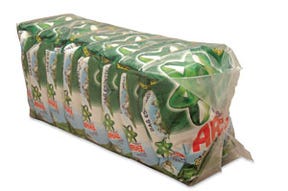 develop clear film bags that replace corrugated shipping cases.
develop clear film bags that replace corrugated shipping cases.
The bags, which are used to ship pallet loads (960 kg) of Ariel granular laundry detergent form/fill/seal sacks in 1.5- to 6-kg sizes, not only cut 80 percent of the case weight but also 20 percent of their volume.
Says senior engineer Ian Bea, “For every point on a product's life cycle, there is a sustainability component right alongside superior performance, quality and value. The new bags retain the speed of the packaging lines but eliminate the need for manual handling at the end of the lines.”
Measuring 15.3x11.4 mm, the clear film bags seal tightly, Bea reports. Before, P&G could pack eight bags of the Ariel detergent into a corrugated shipper, but the shippers were made of a lot of corrugated. The large, clear 3.3-mil, monolayer PE film Polyouters are recyclable, act as a source reduction and can be opened without tools.
“The Ariel packages now look better on shelves because the new packaging process compresses the loads, keeping the bags wrinkle-free in shipment,” adds Bea. He also says the new packaging required P&G to install proprietary bagging machines at the end of existing production lines. The bags are being applied across Central Eastern Europe, the Middle East and Africa , with three more plants to go onstream early next year. The transparent film shows the brands and the sizes and is easy to handle. “There's an easy-open feature so the bag eliminates the need for a knife to open a shipping case,” Bea explains. The bags are also lighter in weight, so are easy to handle by distributors and retailers that can now store more product.
Shelf-ready shipper saves on material
Another convenient shipping container from P&G won an award for a new, shelf-ready version it adopted for Alldays feminine liners marketed by its German counterpart (6). The new two-piece shipping case now comprises a tray-and-hood format that cuts packaging material usage by 28 percent and enhances retail appeal and storage efficiency. Both the German and U.S. portions of P&G are involved in this entry.
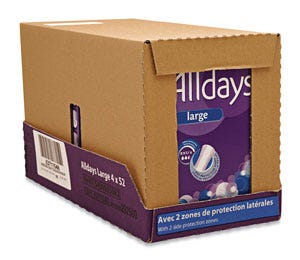
P&G knows that retailers want to reduce the amount of packaging at the store level, so it redesigned the product to fit into smaller packages. The tray-and-hood case concept improves on store labor and consumer appeal on retail shelves because it's sleek, offers product visibility and actually improves store performance. It also uses less printing ink for an 80-percent printing savings. The judges cited it for enhanced performance, cost-effective economics and resource and energy optimization. P&G's R&D associate director Mike Ferrari says the proprietary case saves 1,500 tons of corrugated, 375 truck trips and $1.8 million a year in material costs. The case also speeds up the production line by 33 percent, while shaving 50 percent of restocking time for P&G's customers.
“It creates a more elegant way to ship the shelf-ready packages to market,” he says. Previously, four Alldays cases were packed in a printed corrugated case with a perforation on the bottom edge that allowed store employees to rip off the top and keep the remaining “base tray” for handling and in-store display of the product.
The new tray and a streamlined, detachable hood protect the product, but the hood can be more quickly removed because one end is completely open, exposing the product inside, and the outer container needs no printing. “The perforations often are the cause of improper tears, which creates a low quality look,” Ferrari says. “There are no more perforations and no more knives are needed. When the hood is removed, a clean edge remains. This reduces the burden on stocking personnel. The perforations are replaced with a glue bond between the hood and tray that is more reliably broken by hand.”
Now, only the tray portion of the shipper is printed and no new burdens are created with its execution. The case was launched commercially in Western Europe beginning in January 2009.
Pasta sauce pouch with a twist
Replacing glass jars with shelf-stable, standup pouches that slice 70 percent in structural material is no easy task, but Unilever's standup pouches for Bertolli® and Ragu® sauces (7) do that and more. Produced by Amcor Flexibles, (www.amcor.com), the pouches are microwavable so the sauce can be heated inside quickly and with little mess. And the pouches rival the shelf life of glass jars, according to Humberto Garcia, Unilever's packaging manager for environmental sustainability.
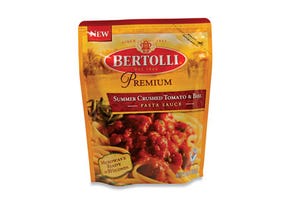 But the transport benefits are substantial: The pouch represents a source reduction of 95 percent for the primary package, on a per-ounce basis and both primary and secondary display-tray packaging represents a 70-percent drop versus with comparbly sized glass packaging, says Unilever. One truckload of unfilled pouches equals 25 truckloads of empty glass jars. Amcor produces the pouchstock of a 104-micron (4.09-mil), seven-color reverse-printed barrier lamination comprising PET, nylon and PP layers. The material achieves key shelf-stability hurdles for the oxygen-sensitive sauces. Launched in January 2008 for six sauce varieties, the pouch is the first nationally marketed for retail pasta sauces in the U.S., Unilever reports.
But the transport benefits are substantial: The pouch represents a source reduction of 95 percent for the primary package, on a per-ounce basis and both primary and secondary display-tray packaging represents a 70-percent drop versus with comparbly sized glass packaging, says Unilever. One truckload of unfilled pouches equals 25 truckloads of empty glass jars. Amcor produces the pouchstock of a 104-micron (4.09-mil), seven-color reverse-printed barrier lamination comprising PET, nylon and PP layers. The material achieves key shelf-stability hurdles for the oxygen-sensitive sauces. Launched in January 2008 for six sauce varieties, the pouch is the first nationally marketed for retail pasta sauces in the U.S., Unilever reports.
Impactful graphics replicate the jar labels and call out product benefits in terms of freshness and the quality of ingredients. The 13.5-oz package also facilitates shipping and warehouse handling, causing product damage. For the packaging launch, the pouches sped up the shelf-stocking process and reduced labor for retailers, Garcia says.
Unilever's pasta-sauce processing technology is considered proprietary so that it can maintain distinctly high-quality product attributes, says Mike Huges, senior manager, packaging. The sauces are contract-packaged by an un-named source on an intermittent motion Toyo Jidoki (www.tyj.co.jp) system. The nonfoil barrier material was a top choicefor microwave heating, Garcia continues.
Less acid; far less packaging
The Prilosec OTC tablet/capsule blister-pack of antacids from Procter & Gamble and Alcan Packaging (www.alcanpackaging.com) (8) was overhauled in an industry-standard approach, according to Cincinnati-based P&G. Noted for its economics and enhanced performance, the new structure doubles the number of pills available on a blister-card so that consumers can have an entire course of treatment on a single card. This cuts packaging waste. Before, Prilosec was in a blister-card that held seven tablets with a peel-and-push, child-resistant access device. But the product must be taken for 14 days, so two cards were required.
The Prilosec team cut packaging material use in half with the redesigned and cartoned package of blister “sheets.” One sheet holds twice as many tablets as before, and makes the tablets easier to access. Not only does the package offer an entire course of treatment on a single blister-card, it saves a whopping 800,000 lb of packaging material/year. Also, it cuts carbon dioxide emissions during production in half.
The new package began distribution nationally last year. Due to tablet sensitivity, it's made using a foil/foil 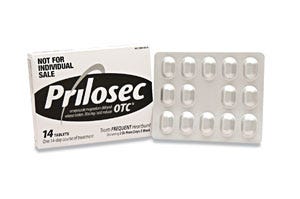 construction that provides certain required barriers. Conventional cold-formable foil blister cavities often result in what looks like oversized cavities. P&G's John Eadicicco, of package development for the pharma and digestive wellness business, explains that this is because foil doesn't form the same way as thermoformable materials do, which basically flow during forming. The redesigned package uses foil formed in a series of draft angles that allow it to create a cavity shape without sharp angles that could cause stress points and create cracks or holes. This change created a smaller cavity length and width, and testing showed the new design to still be in a safe forming range, he says. The package also has a new easy-open, push-through feature replacing the former peel-and-push device. The former design required Prilosec users to separate each cavity to gain access to unsealed areas as part of the opening instructions. The lidding material meets the company's safety requirements for child-resistance.
construction that provides certain required barriers. Conventional cold-formable foil blister cavities often result in what looks like oversized cavities. P&G's John Eadicicco, of package development for the pharma and digestive wellness business, explains that this is because foil doesn't form the same way as thermoformable materials do, which basically flow during forming. The redesigned package uses foil formed in a series of draft angles that allow it to create a cavity shape without sharp angles that could cause stress points and create cracks or holes. This change created a smaller cavity length and width, and testing showed the new design to still be in a safe forming range, he says. The package also has a new easy-open, push-through feature replacing the former peel-and-push device. The former design required Prilosec users to separate each cavity to gain access to unsealed areas as part of the opening instructions. The lidding material meets the company's safety requirements for child-resistance.
Spruced-up gift-pack that keeps on growing
Revised holiday gift packaging from ecocentric bodycare maker, Pangea Organics (9), Boulder, CO, has emerged as a renewable, biodegradable recycled-content molded fiberboard clamshell carton filled with bodycare essentials and cushioned with recycled-content rafia. Made by UFP Technologies (www.ufpt.com) with zero waste, glue or dyes, the hinged clamshell is made of 100-percent post-consumer newsprint and is decorated on the outside only with a large paperboard band label that supports this product line's organic branding yet with sleek, sophisticated shelf appeal.
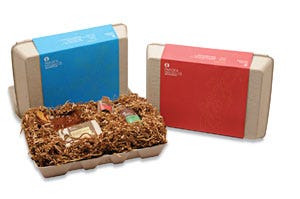 A significant sustainability achievement in the gift-pack category, this redesign, judges said, fits with the brand's organic positioning and attractiveness while substantially reducing packaging waste. The clamshell is renewable, recyclable and biodegradable. Made of Monadnock's (www.mpm.com) Astrolite PC 100 paper, a 100-percent-recycled fiber, the overband is printed with vegetable-based inks, Pangea says.
A significant sustainability achievement in the gift-pack category, this redesign, judges said, fits with the brand's organic positioning and attractiveness while substantially reducing packaging waste. The clamshell is renewable, recyclable and biodegradable. Made of Monadnock's (www.mpm.com) Astrolite PC 100 paper, a 100-percent-recycled fiber, the overband is printed with vegetable-based inks, Pangea says.
The important environmental attributes of the hinged clamshell are within. Seeds are actually embedded into the container so that it can be “planted” after use. After the label is removed and the container is flattened, it can be soaked in water for 24 hr and planted about 1/8 in. into the ground. Pangea says in about two weeks, the seeds begin to germinate into the beginnings of a spruce tree.
Priced at $35, the Harmony gift set includes a 3.75-oz of bar soap, a 8.5-oz HDPE bottle of shower gel, a sample-size hand and body lotion in a 0.1-oz paperboard laminate “tube.” Launched in September 2008, the clamshell features a recycled-content, carbon-neutral paper overband that's color-coded to coordinate with the selection of products inside the package.
Produced and offset-printed by Johnson Printing (www.jpcolorado.com) using soy-based inks, the copy on two sides of the band details the company's, handcrafted, organic and cruelty-free manufacturing princicples, and facts about the package. A supporter of the Forestry Stewardship Council, Pangea urges buyers to skip the wrapping paper, save a tree and give the gift of less waste. “We believe the fringe predicts the future; therefore, we always try to stay on the fringe of design,” says Joshua Onvsko, founder and CEO of Pangea Organics.
“The goal is to create products with little to no environmental impact,” Onvsko says. “If everyone would plant their container this year, we'll have collectively planted 122,000 trees. That's equivalent to saving 30 million miles of driving in one year.”
Frugal F-style jug
A redesigned 20-L jug with built-in handles on two sides and a tamper-evident, mechanical closure (10) from A & C Packers Pty Ltd. (www.aandcpakcers.com.au) of Australia is 30-percent more efficient for transport and storage of Chlorpyrifos 500 insecticide. It's also reusable and recyclable at the end of the product's life. The new barrier structure replaces steel drums in common solvent applications and is reusable, with a five-year life, compared to the previous one-time usage life. The new design enables better stacking and cube efficiency—a 30-percent improvement.
An easy-pour “glug-free” neck design also helps avoid spills or splashing when pouring. Recognized for effective recovery and enhanced performance, the opaque white container can be recycled and made into items such items as drain pipes. Mark Stone, CEO at A&C Packers, says that most 20-liter drums used in Australia are generic in shape and the dimensions only permit 16 drums per layer on a standard-sized pallet (in Australia, that's 45.6x45.6 in.). Most often, full containers are shipped two-layers-high so only 640 liters of product was able to be put on a pallet.
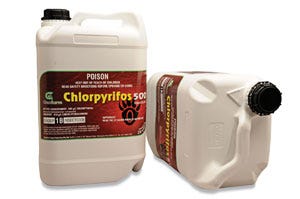 “The new drum shape allows you to pack twenty drums per layer, two high, to ship 800 liters in the same space,” Stone says. “Freight from the warehouse to the distribution center and then to the customer is at pallet freight rates. This is where savings can be made. Our customers estimate a five-percent freight savings, overall.” The savings apply to warehousing throughout the supply chain,” Stone adds.
“The new drum shape allows you to pack twenty drums per layer, two high, to ship 800 liters in the same space,” Stone says. “Freight from the warehouse to the distribution center and then to the customer is at pallet freight rates. This is where savings can be made. Our customers estimate a five-percent freight savings, overall.” The savings apply to warehousing throughout the supply chain,” Stone adds.
Most drums used in Australia are made of HDPE, Stone tells PD. The material accommodates water-based products well, but may not be compatible with agricultural products such as fungicides and pesticides that are solvent-based. In these circumstances, containers might have to be fluorinated and freighted to the only flourinator in Australia, which is located in Sydney. The extra flourination process is very expensive, Stone adds.
To bypass the additional step, A&C Packers developed a proprietary six-layer container based on HDPE and polyamide (DuPont's Selar), that needs no fluorination. Stone will only say the drums are extrusion/blow-molded on equipment that can produce up to 2,000 drums per day. The construction not only saves additional freight costs to Sydney and fluorination charges, but also reduces the cost of the container by around 12 percent. The 63-mm, no-glug cap from Dorony Pty Ltd. (03 9427 1505) is a tamper-evident, wedge-seal design that works by positioning the neck and changing the pouring direction so that no bubbles become trapped inside the jug. Stone says the bottle neck controls the pour from start to finish, without glugging, in about one-third the time it takes to empty a conventional drum. “Market acceptance has been exceptionally high of the new drum,” he concludes. “One customer purchased our total production capacitiy for the first year and more than 120,000 of the drums have been sold in the last twelve months.”
The first barrier layer versions of these containers were produced in October 2008. Stone says that the container has received UN certification for dangerous goods and that six large chemical companies are currently conducting stability trials on the revised 20-L jug.
More information is available: |
DuPont Packaging and Industrial Polymers, 302/992-4204. www.packaging.dupont.com. |
A&C Packers Pty Ltd., 61 732652 700. www.aandcpackers.com.au. |
Alcan Packaging Pharma Center, 502/647-2300. www.alcanpackaging.com. |
Amcor Flexibles, 301/745-5000. www.amcor.com. |
Associated Packaging Technologies 484/785-1120. www.aptechnologies.com. |
Biosphere Industries, LLC, 805/566-6563. www.biosphereindustries.com. |
Ecolean Group, 46 52 450 00. www.ecolean.com. |
Matrix Packaging, 905/624-2337. www.matrixpackaging.com. |
Sealed Air Corp., 864/433-3290. www.sealedair.com. |
UFP Technologies, 800/372-3172. www.ufpt.com. |
About the Author(s)
You May Also Like


